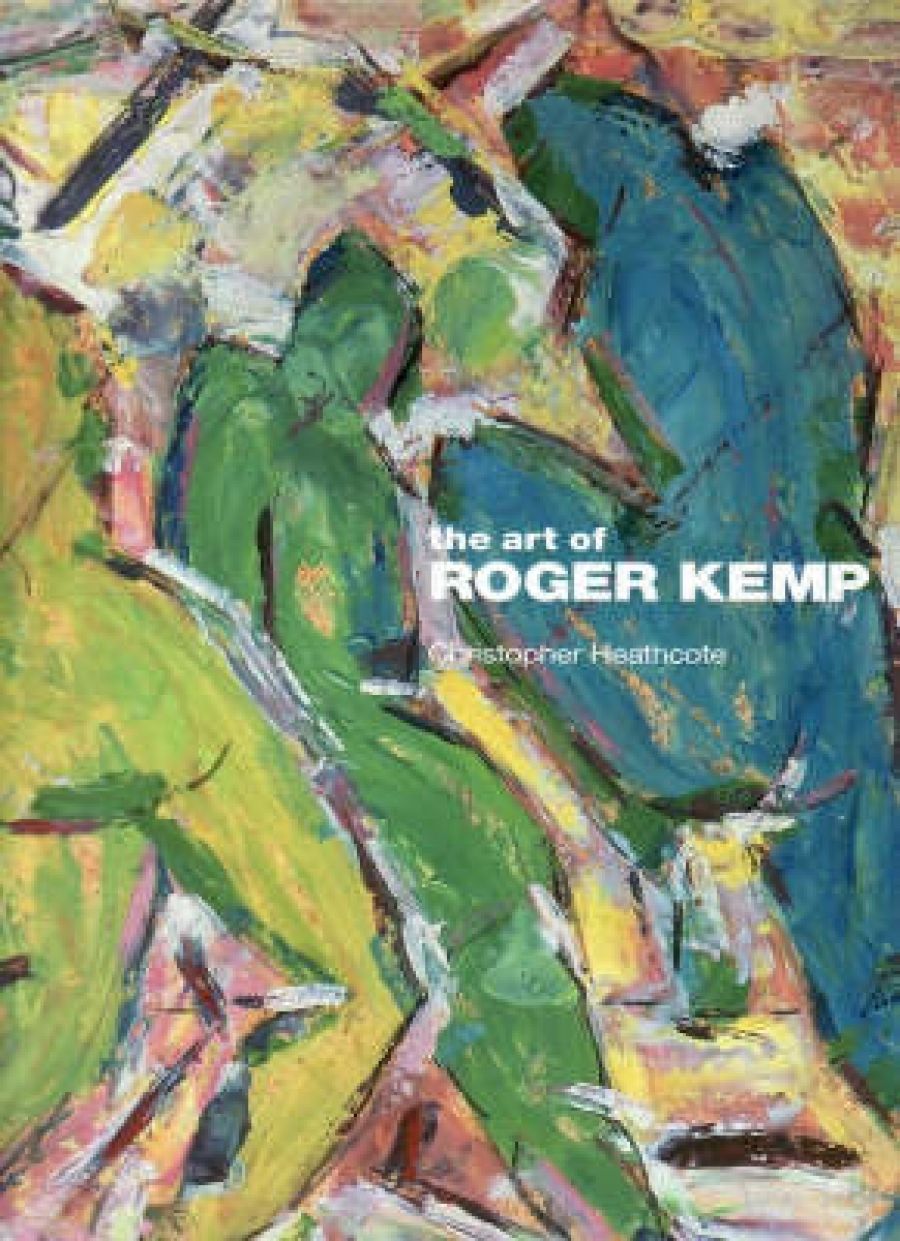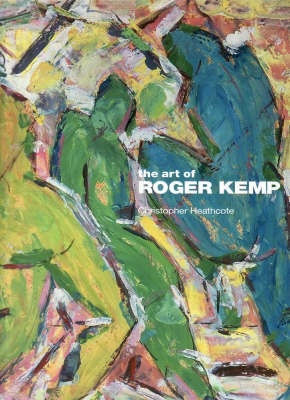
- Free Article: No
- Custom Article Title: Enigmatic Kemp
- Review Article: Yes
- Article Title: Enigmatic Kemp
- Online Only: No
- Custom Highlight Text:
Christopher Heathcote’s scholarly study of the abstract artist Roger Kemp (1908–87) took more than a decade to complete. Heathcote’s examination of this Melbourne-based painter provides a refreshingly different view of Melbourne’s art scene from the 1930s to the 1980s and opens up new vistas beyond the much-studied Angry Penguin circle.
- Book 1 Title: The Art of Roger Kemp
- Book 1 Subtitle: A quest for enlightenment
- Book 1 Biblio: Macmillan Art Publishing, $99 hb, 271 pp
- Book 1 Cover Small (400 x 600):

- Book 1 Cover (800 x 1200):

Heathcote’s account of the artist’s life and work skilfully balances historical context with close visual analysis of individual works. Kemp did not leave a diary, personal testament or many letters, but Heathcote more than makes up for this: he draws upon his own recollections of the artist, recorded interviews, the memories of families and friends, an exhaustive analysis of available documentary evidence, and extensive contextual research. The study is made all the richer by the inclusion of more than sixty pages of high-quality plates covering the artist's oeuvre, alongside relevant photographs of Kemp and friends. The bibliography and the list of solo exhibitions (complete with all works shown and relevant exhibition reviews) form a valuable scholarly resource.
Kemp is perhaps best known for the series of three tapestries completed by the Victorian Tapestries workshop for the Great Hall of the National Gallery of Victoria in 1984. Based upon Kemp’s paintings of the 1960s, these partmodemist, part-medieval style works make them a perfect adjunct to the stain-glass ceiling of Leonard French. Despite this achievement, Kemp is not as widely known as his younger contemporaries, including Arthur Boyd and Sidney Nolan. Heathcote is right to argue that Kemp’s achievements should be more widely recognised.
Heathcote suggests reasons why Kemp has not achieved similar recognition. First, his abstract oeuvre moved in and out of fashion, peaking in the late 1960s and early 1970s. The formalist theories of Clement Greenberg did not sit well with Kemp’s more romantic approach. Second, Kemp failed to attain international recognition. He was offered an exhibition at London’s Redfern gallery, but this was withdrawn when the artist returned to Australia. In addition, unlike many Australian expatriate artists of the period, his work was not easily recognisable as ‘Australian’ art, making it less marketable internationally. Finally, Kemp did not belong to any school, and worked upon his metaphysical abstract paintings as an individual artist. Although he knew the Heide Circle artists, the Contemporary Art Society and the Victorian Art Society, he was not closely associated with them.
Kemp, then, is rather enigmatic, and it is this that makes the study so intriguing. How did this relatively isolated artist move away from the nineteenth-century painting techniques he learnt at the National Gallery School towards a modernist art practice? Heathcote identifies the influence of George Bell, Arnold Shore and William Frater, the impact of art magazines available at Gino Nibbi's art bookshop, and the Herald Art Show of Modern Painting. However, it is his discussion of the role that the Ballets Russes played in introducing modernist ideas to Australia that is particularly fascinating. The set designers included Andre Derain, Andre Masson, Giorgio de Chirico, Juan Gris, Joan Miro, and Georges Rouault. Dancing figures became a central feature of Kemp’s early modernist works.
A particularly fascinating section of the book discusses how Kemp’s inclusion of ‘heliotropes, unearthly fires, winged figures, tower like mountains and visionary flowers’ within his work of the 1930s and 1940s was inspired by the metaphysical ideas of the Christian Scientists and the theosophical movement. Both groups believed that art offered universal truths underlying a material movement, and that there was a synthesis between science, religion, and philosophy. The synchrony between art and music was another fascination of the artist. Heathcote's description of Kemp’s graphic works captures this synthesis beautifully. He describes how ‘each line is meant to hum like a low mantra’.
Heathcote alludes to, but does not fully explore, the impact of women both within Kemp’s life and upon the modernist art scene in Melbourne. It is an area worthy of further study. Kath Miller, Helen Ogilvie, Janet Dawson, Inge King, Elisabeth Vasilieff and Lina Bryans were only a few of the remarkable women who were friends and associates of Roger Kemp. His own wife, Merle Kemp, had been an artist and fabric designer of some talent. However, we are told that she ‘cheerfully and uncomplainingly set aside her own brush to deal with galleries and organise their home’.
In addition to the study of Kemp’s life and work, Heathcote has included three short essays that seem intended to provoke debate. ‘The Young Artist’ vividly criticises the formulaic nature of many artists’ biographies in which ‘the author has arranged details on a stage like a portable scenery from a theatrical workshop’. Heathcote is particularly critical of art historians who arrange subject matter to support political agendas. He prefers Kemp’s notion that ‘we do not deal with facts but with values: with emotion mood, imagination creativity, and personal vision. Our most authentic experience of a picture remains that solitary inward joy of looking – when the viewer's mind is touched.’
‘Art and Faith’ discusses the relationship between the avant-garde innovator and the world. In this context, Kemp is characterised as an innovative metaphysical artist who ‘reveals to us a hidden enchanted order beyond the materialistic world’.
Heathcote’s final essay, ‘Path to Understanding'’ claims that we have lost the ability to read the meaning in forms, colours and shapes. We characterise artists either as producers who pre-arrange existing forms or as creators with special gifts. Heathcote talks of the ethical responsibilities given to the art historian, who must resist the temptation to embellish historical accounts. When Heathcote claims that Kemp’s etchings are of such magnitude that only William Blake’s Jerusalem series rivals them, one can’t help thinking that he has given in to this temptation. Even if one is sympathetic to Heathcote’s aim of reasserting Kemp as a significant artist, this statement fails to convince.
Equally simplistic is Heathcote’s statement that ‘recent art history takes the view that there are no inherently “good” pictures’ because, according to postmodernist theory, ‘artistic preferences are determined entirely by regions, race, age religions, sex and class’. Possibly to avoid what Heathcote dismisses as a ‘sociological approach’, not until the acknowledgments does he reveal his own close relationship with Kemp as a former student and friend. Given the profound impact that his association with the artist had upon this text, an earlier declaration of this personal connection would have been valuable.
Nevertheless, this is a stimulating and thought-provoking study that both gives an insight into the life and art of Roger Kemp and considers many vital questions concerning the ways in which the Australian art canon is shaped. What is the role of patronage? To what extent do political, national and fashion agendas determine who is included within the art canon? How does one assert the value of an artist who operates outside the boundaries of a particular group, theory or metropolitan centre? How should one write about art? Does art have an intrinsic aesthetic value and if so, what kind?
This book is vital for anyone interested in Australian modernism and serves as an important adjunct to Heathcote’s ground-breaking study of postwar Australian art A Quiet Revolution (1995).


Comments powered by CComment